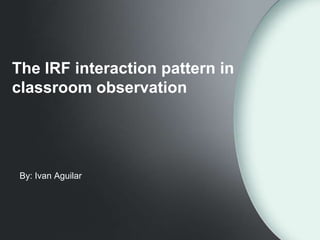
The irf interaction pattern in classroom observation
- 1. The IRF interaction pattern in classroom observation By: Ivan Aguilar
- 2. Presentation objective: • Participants will be able to explain how teacher’s feedback responses affect students’ learning.
- 3. To start • Get in pairs • Decide who is A and B • A: Ask questions to B in order to keep him/her speaking for as long as possible. • B: Answer A’s questions and try to remember at least four of the questions A used to keep you speaking • Keep the questions for later discussion
- 4. THIS PRESENTATION This presentation is a brief report on the use of the IRF classroom interaction pattern during class observation.
- 5. CLASSROOM INTERACTION “the patterns of verbal and non-verbal communication and the types of social relationships which occur within classrooms. The patterns of classroom interaction may be a part of studies of classroom discourse” Taken from: Dictionary of language teaching and applied linguistics, Richard-Schmidt
- 6. THE IRF INTERACTION PATTERN The IRF interaction pattern stands for Interaction-Response- Feedback. It is the minimum kind of interaction that takes place in the classroom. Most of the time, this pattern consists of a question initiated by the teacher, a response given by the student, and feedback provided by the teacher. • INITIATION: Where did you travel? • RESPONSE: I traveled to Cuzco. • FEEDBACK: Good! (We will focus on this third turn!!)
- 7. THE CATEGORIES TYPES OF FEEDBACK EVALUATIVE FEEDBACK Indicates that the learner’s T: What’s your favorite sport? (POSITIVE)=EFP response is acceptable. S1: Soccer (Accepts, evaluates, and T: Good, I like soccer too. comments). EVALUATIVE FEEDBACK Immediate oral feedback T: Who is Elaine? (NEGATIVE)=EFN which aims at mistake S1:She’s my /dauter/ correction. (Recast, T: daughter (showing Elicitation, Metalinguistic correction) Clue,) REPETITION=REP Repeating what the student T: what do you do on the said. weekend? S1: I clean my house. T:Ok, you clean your house INTERACTIVE=INT A strategy to expand or T: what do you remember modify students’ answer about the story? S1: She took her sister to the hospital? T: And then, what did she do?
- 8. GATHERING OF INFORMATION a. Samples were taken during whole class setting. b. Samples were collected only when the teacher initiated the exchange. c. Samples were collected during a month observation. Some samples were rejected since they were based more on contextual clues than teachers initiation.
- 9. FIRST RESULTS PERCENT Eval. Feed. + 36% Eval. Feed. - 30% Repetition 8% Interactive 26% 100%
- 10. OTHER FEATURES DETECTED a. 26% of the teacher’s questions were addressed to the whole class. b. 18% of teachers’ positive evaluative feedback were followed by extended comments. c. 30% of students reponses consisted of silence or single word responses.
- 11. WHAT THEORY SAYS ABOUT THE TEACHERS’ FEEDBACK “The feedback from the teacher enhances learners’ acquisition of language. This IRF pattern supports and promotes interaction more effectively if the teacher utilizes the third turn to provide further opportunities for interaction rather than using evaluative comment (Antón, 1999;Hall, 1998; Hall & Walsh, 2002; Ohta, 2001; Walsh, 2002).”
- 12. SOME IDEAS FOR THE THIRD TURN • Avoid echoing or repeating what your students say: Not so good Improved T: What did you do last T: What did you do last night? night? S1: I went to the movies. S1: I went to the movies. T: You went to the T: Good. How did you movies. Good. You went like the movie? to the movies.
- 13. SOME IDEAS FOR THE THIRD TURN • Avoid helpful sentences completion. Not so good Improved T: What do you think T: What do you think about smoking? about smoking? S1: Smoking is S1: Smoking is… …(pauses) T: (wait time) How can T: (immediately)A bad you say it in a different thing, yes I agree way?
- 14. SOME IDEAS FOR THE THIRD TURN • Using clarification requests. Not so good Improved T: What did you do on T: What did you do on mother’s day? mother’s day? S1: I gift my necklace my S1: I gift my necklace my mother. mother. T: Good! A necklace is T: What do you really beautiful. mean?
- 15. SOME IDEAS FOR THE THIRD TURN • Avoid extended comments. Redirect it intervention to the class. Not so good Improved T: Where would you like to T: Where would you like to travel? travel? S1: I’d like to travel to Cuzco. S1: I’d like to travel to Cuzco. T: Yes Cuzco is great. I T: Great! What are two things traveled there last month. It you would like to do there? was beautiful. I stayed in a nice hotel and I tried its typical Or food. Next time, I’ll visit T:Great! Does anyone else Mancora. like Cuzco? Why?
- 16. SOME IDEAS FOR THE THIRD TURN • Your idea… • Prepare an IRF interaction pattern to show your own suggestion. Think about the questions used at the beginning of this presentation or other concepts like “reciprocal teaching”. Your idea… T: S1: T:
- 17. Conclusions • By monitoring how we react to our students’ responses, we can reduced our talking time and make classroom interaction more interactive. • Your conclusion
